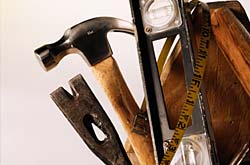Home Improvement Southwest-Style
See if We Have Top-Rated
Home Improvement Professionals in Your Area

Within the sphere of home improvement and residential construction, the Southwest region takes on slightly different boundaries. While Denver and Salt Lake City are more aptly described as the Mountain West in geographic terms, these cities share many of the same residential remodeling tendencies as their counterparts to the South. Los Angeles, meanwhile, more closely follows the coastal tendencies with its moderate climate and relatively wealthy populations. From west central Texas to Arizona and up through Colorado, Utah, and Nevada, the following metropolitan areas and remodeling projects show what it means to do home improvement Southwest-style.
The Sunny Southwest: Leader in Residential Solar Energy
Of course, it comes as no surprise to most people that the Southwest is a leading region for solar-powered technology. Although sufficient sun exposure applies to more regions than most people believe, the marketability and efficiency of solar panels in the sunny Southwest has inculcated solar-power technology, education, and availability for homeowners. It's still expensive, but it's also become more cost-effective than ever before.
Interestingly, residents in different cities may have different energy needs and priorities. Generating enough energy for your entire home with solar power is a different prospect than solar hot water heaters. Las Vegas leads the way in solar panel/electrical system installation at least in terms of homeowner interest, while Phoenix is the poster child for solar water heating systems. The national average for solar powered electrical systems in 2008 was 1 request per 4,496 people, while Las Vegas more than doubled this rate with 1 request per 2,118 people. For solar water heaters nationwide, the rate was 1 request per 104,695 people; Phoenix was at 1 request per 46,438 residents.
With Stucco Siding, Pragmatism Creates Culture
The look of stucco siding is inexorably tied to the Southwest, but it isn't just the rugged culture of the Southwest that gave rise to this building material. Stucco works well in extreme heat to keep interior spaces cool. Traditional stucco, with cheaper installation costs and greater structural durability, remains dominant within the larger stucco industry. For this material, Phoenix again is king. With the national average at 1 request for every 79,996 people, Phoenix more than doubled this rate with 1 request for every 31,190 people.
Exterior Insulation and Finish Systems (EIFS), more commonly known as synthetic stucco, is even further ensconced in the Southwest region. Superior insulating values and design versatility gave rise to this siding system in the 1980s, although it was soon discovered that without a water drainage system, synthetic stucco could trap moisture behind your walls, causing wood framing to rot. Thus, in higher altitudes where less moisture is present, synthetic stucco remains popular, though as new, improved EIFS systems become more credible, the siding will likely branch out. Right now, Salt Lake City is the dominant metropolitan area for synthetic stucco. While the national average for 2008 was 1 synthetic stucco siding request for every 180,311 people, Salt Lake City more than quadrupled this rate with 1 request for every 43,999 residents.
Arid Landscaping Schemes
Contrary to the perception of some outsiders, homes and cities in the Southwest are not full of deserts and cacti, but arid landscaping is, indeed, a major concern for homeowners who care about their home's curb appeal and land and water conservation. Xeriscaping—landscaping and gardening schemes that reduce or eliminate the need for irrigation—gives a significant boost to landscaping companies. In particular, the Mile High City is known for its xeriscaping and landscaping design. Nationwide, landscaping installation for a yard or garden saw 1 request for every 5,917 people, while Denver nearly tripled this rate with 1 request for every 2,064 residents.
Naturally, you might think in area where water is a precious commodity, sprinkler system installation is shunned. Yet, arguably, the greater the restriction on lawn irrigation, the greater is the need for such systems. Mid-morning, when most people are at work, tends to be the best time to water your lawn for hot, dry climates. Watering your lawn in the afternoon will cause a significant amount of moisture to evaporate. Watering your lawn overnight can lead to standing water that will promote the growth of lawn fungus and disease. A well-designed sprinkler system will ensure water is delivered evenly, optimally, and automatically to your lawn. San Antonio leads the way for sprinkler system installation: With the national average at 1 request per 15,253 people, the Alamo City saw 1 request per 5,104 people last year.
Surprising Result
Although the Southwest is one of the unmistakable epicenters of the housing crisis, many home improvements are forward-thinking and likely to generate a housing stock with long-term viability. If you live in the Southwest, if you're thinking about relocating, or if you're just interested in regional considerations for residential construction, you would do well to capitalize on a home that plays to the region's strengths.
Many of the home improvements prevalent in the southwest are common sense to native homeowners and contractors, but some projects that are supposedly linked to sunny climates don't translate as well as you might believe. Evidently misnamed, sunroom additions are actually less popular in the southwest with not a single major city breaking the national average. A number of contributing factors may explain this sagging popularity. First, sunroom additions are often built as an inexpensive way to increase living space. The ample space and relatively new housing stock—not to mention unwise lending practices—allow many homeowners to build or buy a home that already has more than enough square footage. Second, logistically speaking, space heaters can be more economical than A/C window units for sunrooms, allowing moderate climates to more easily expand seasonal use. Finally, most southwest residents don't need a room to add sunlight to their daily routine.
More Tips & Advice For Your Home
- Related Articles
- Recent Articles

